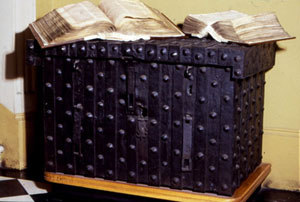In 1086 King William the Conqueror initiated a great survey of the 37 counties of England and part of north Wales. This survey took only seven months which indicates the efficiency of the administrative and judicial processes in place at the time.
The survey was done county by county, and within each county the entries were by landlord. Each landlord could hold rights to land in several hundreds, all over the county, so individual settlements or villages may be referred to on many different pages.
An Anglo-Saxon scribe described the making of Domesday Book in Version E of the Anglo-Saxon Chronicle for the year 1085:
"Then at Christmas the king was at Gloucester with the council and held his court there for five days, and then the archbishop and clerics had a synod for three days. There Maurice was elected Bishop Of London, and William for Norfolk, and Robert for Cheshire: they were all clerics of the king. After this the king had much thought and very deep discussion [mycel geðeaht and swiðe deope spæce] with his council about this country — how it was occupied and with what sort of people. Then he sent his men over all England into every shire and had them find out how many hundred hides there were in the shire or what land and cattle the king himself in the country, or what dues he ought to have in twelve months from the shire. Also he had a record made of how much land the archbishops had, and his bishops and his abbots and his earls — and though I relate it at too great length — what or how much everybody had who was occupying land in England, in land and cattle and how much money it was worth. So very narrowly did he have it investigated, that there was no single hide nor virgate of land, nor indeed (it is a shame to relate though it seemed to him no shame to do) one ox nor one cow nor one pig which was there left out, and not put down in his record [on his gewrite]; and all these records were brought to him afterwards."
The scale of the survey was unprecedented in Europe at the time, and not repeated in Britain until the census in the 19th century. Although its exact purpose is unclear, the Domesday Book records people's rights to land and their duties to give tax and military service.
The administrative systems used were essentially those of the Saxon Kings from before 1066. This illustrates the highly developed nature of English government before the Conquest.
When the survey was completed, the task of evaluating all the reports and abridging them into a codified form was undertaken centrally. The resulting book was known as the Book of Winchester, or Liber de Wintonia, and was, of course, written by hand, and was in Latin. Writing up the Book of Winchester after the survey took up to four years.
Bishop Henry of Winchester, King William's grandson, wrote that "the natives called it Domesday Book, by analogy from the Day of Judgement".
The Domesday Book was first bound around 1100, in two volumes subsequently distinguished as Great and Little Domesday. Their names refer to the size of their parchment leaves rather than to their bulk. The folios of Great Domesday measure 15 x 11 inches, but those of Little Domesday, which was slightly the fatter volume, measures 11 x 8 inches.
Great Domesday covers most of England except for Suffolk, Norfolk and Essex, which make up the contents of Little Domeday. Great Domesday also excluded Northumbria, possibly because it had not been shired into Hundreds and therefore had no local government structure as such. Cumberland was also excluded because it was effectively part of Scotland at the time.
Great Domesday was also much more consistent and structured in its recording than Little Domesday, and was produced in much less detail and in a different page format. For these reasons, scholars have concentrated upon Great Domesday, and so the three counties of East Anglia have been somewhat neglected.
|
Modern editions of the Domesday Book
|





